Power saw buying guide
Power saw buying guide
Introduction
Whether you’re an experienced tradesperson or DIYer, a power saw can make light work of any cutting tasks you have. But there are many types of saw available, all with different uses.
This comprehensive power saw buying guide will help you decide. It covers the different types of saws and their uses. We look at which electric saw to use on various materials and the kind of cut they can make. And we explain the different features, power ratings and battery technology. Finally, we highlight some key things to consider when buying a power saw and answer some frequently asked questions.
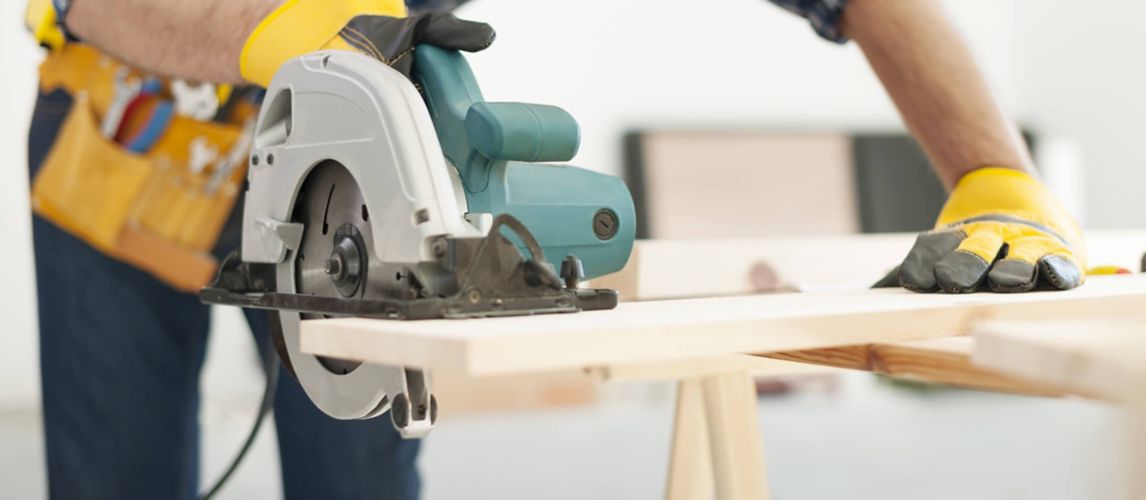
What Power Saw do I Need?
Power saws are an essential piece of kit for many cutting jobs. But, when you’re deciding which one to buy, there are several factors to consider.
The most important question is, what will it be used for? Because every type of power saw has different uses. You’ll need to consider the material you’ll be cutting and the kind of cut you want (i.e., straight lines, angles, curves, etc.).
Another thing to consider is how often you'll use it. For example, if it's for infrequent DIY use, you probably won't need as much power as a tradesperson who will use the tool frequently. Your budget is also something to consider.
Corded or cordless?
The difference between corded power saws and cordless power saws is how they are powered. A corded power saw is plugged into the mains electricity supply. In contrast, a cordless power saw is powered by a built-in battery.
The decision on which of these electric saw types is best should be based on where you are working and the job you are doing. Consider these pros and cons below:
Corded power saw pros:
- Corded power saws tend to be more powerful than their cordless equivalents
- There’s no limit to how long you can use them, making them the best choice for longer tasks
- They are the best option for static power saws because the saw stays in one place
Corded power saw cons:
- Most corded power saws come with a short cord (usually 1m), so you need to be near a plug socket or drag an extension lead around
- Trailing cables are dangerous when using a power saw
- The cord makes them unsuitable for working up a ladder or on scaffolding
- The cable on a handheld power saw can make it difficult to cut with precision
Cordless power saw pros:
- They’re convenient
- They give you greater mobility than a corded power saw
- They are safer to use as there are no trailing power cables
- Being free of cables makes it easier to cut with precision
Cordless power saw cons:
- Cordless power saws tend to be less powerful than their corded equivalents
- The battery life limits how long they can be used each time
Brushed or brushless?
On power saws, the terms brushed and brushless refer to their motor type.
Brushed power saws have a motor that’s driven by small metal brushes. Whereas brushless power saws have a motor with an electronic circuit board and sensor. A brushless motor has reduced friction and heat build-up compared to a brushed motor. This makes the power saw more responsive to the material it’s cutting and increases its lifespan, which is ideal if you use the power saw frequently.
Types of Power Saw
There are many types of powered saws available, so it can be hard to know which one to buy. This section explains the different types of power saws and their uses to help you decide.
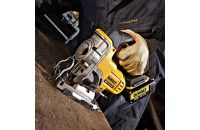
Jigsaw explained
Jigsaws are handheld, portable saws with a narrow, reciprocating blade aimed downwards. They are designed to make a variety of cuts, from straight cuts to intricate curves. This makes them ideal for cutting shelving, worktops, laminate flooring and skirting boards. They can also be used to cut shapes out of the middle of a piece of material. All you need to do is drill a hole for the blade to enter. With the right blade, jigsaws can cut through various materials, including wood, plastic and sheet metal. In addition, some jigsaws have an orbital action function, which lets you make very fast cuts in wood.
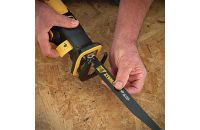
Reciprocating saw explained
Reciprocating saws are handheld, portable saws with reciprocating blades that jut out from the saw's nose. The blades are interchangeable to allow them to cut many types of materials of different densities. They are designed for quick and efficient cutting rather than precision cutting. They are often used for demolition work to cut and rip out door frames, windows, joists, plasterboard, etc. With the right blade, reciprocating saws can cut through a wide variety of materials, including wood, metal, plastic, man-made boards and tree branches.
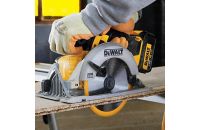
Circular saw explained
Circular saws are handheld, portable saws with a circular, rotating blade that juts out from a plastic casing. They are designed to cut straight lines in sheet materials, such as timber, MDF and plywood. They are ideal for cutting kitchen worktops, doors, laminate flooring and decking. They can also cut framing lumber, roofing, metal, and masonry with the right blade.
What is a rafter hook on a circular saw?
A rafter hook is a metal hook attached to the top of a circular saw. It's a simple yet handy attachment that lets you hook the tool onto a ladder or nearby structure when you're not using it, making it convenient when working at height.
Orbital jigsaw vs circular saw
An orbital jigsaw can quickly cut straight lines in wood, as can a circular saw. So, you may find it difficult to decide which of these tools is best for you. When choosing, consider that circular saws are more diverse. They can be tilted to make cuts at varying angles. The depth at which the blade cuts can be adjusted to make it easier to cut thicker materials than using a jigsaw. A jigsaw is more suited to making complex shaped cuts.
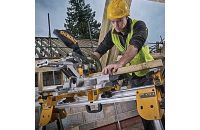
Mitre saw explained
Mitre saws consist of a circular cutting blade held on a swivelling arm over a small platform. The platform has a guide that can be adjusted and set at various angles. They are designed to make cuts at different angles in wood, plastic, alloys and nonferrous metals. This makes them ideal for cutting skirting boards, door frames, picture frames, etc. Some models (called compound mitre saws) have a tilting blade to cut bevelled edges. And some have a sliding mechanism that moves the blade back and forth, allowing you to cut larger pieces of material with a greater thickness, such as fence posts.
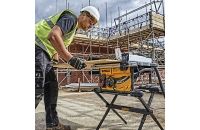
Table saw explained
Table saws are portable saws consisting of a fixed circular blade jutting out of the top of a table. Unlike circular saws, the blade spins in a stationary position. The user pushes the material into the blade to be cut. They are designed to cut sheet materials such as wood, plywood, MDF, plastic and soft metals. They cut straight lines but can cut angles (using a mitre gauge), and some also have tilting blades for cutting bevels. The blade can also be moved up and down to control the depth of the cut.
Other types of saw
The power saws above are the most used, but there are a few other types to be aware of:
Plunge saws make smooth, straight cuts and are often used with a track or guide to improve accuracy. They have a circular blade which is plunged down into the material, which means cuts can be started in the middle, if necessary, i.e., to cut a sink or hob hole in a worktop.
Bandsaws are handheld saws that work by moving a band of metal between two wheels to cut a wide range of materials. Bandsaw uses include cutting tubes, pipes and curved objects. There are vertical and horizontal models available.
Chop saws have a circular blade attached to an arm that moves up and down over a small platform. They are specifically designed to cut through hard materials such as metal, brick, plastic, concrete and masonry.
Tiles saws are specifically designed to cut ceramic, porcelain and glass tiles as well as granite and marble. They use a special diamond blade that gives them cutting power without breaking or chipping the material.
Scroll saws are precision cutting tools that use ultra-fine blades to cut intricate shapes. This tool is often used by woodworkers who create wooden toys or jigsaw puzzles.
Insulation saws are specialised tools designed to cut insulating materials made of mineral fibres and natural fibres. This tool is ideal for tradespeople who cut insulation regularly.
Alligator saws are handheld, portable saws that use two blades moving in opposite directions, jutting out from the nose of the saw. They provide accurate, straight cuts and great control when cutting through construction materials such as timber, aerated concrete, hollow clay blocks and insulation.
Panel saws consist of a circular saw fixed to a long rail. The rail guides the circular saw up and down to cut straight lines. These saws are designed to cut large sheet materials into smaller sections. They can cut wood, plywood, OSB, MDF, laminated sheets, acrylic, plastic and metal.
Types of Cut
When buying a power saw, it's essential to know what type of cut you will need to make, as some are more suited to specific cuts than others.
This section lists which saw types are suitable for different kinds of cuts, alongside the materials and applications they may be used for.
Straight line
- Jigsaw: can make good straight cuts in wood, metal, plastic and aluminium. Ideal for cutting shelving, worktops and laminate flooring.
- Reciprocating saw: can make rough straight cuts in wood, metal, plastic and man-made boards. Ideal for demolition work.
- Circular saw: can make precise straight cuts in sheet materials like timber, MDF, and plywood. Ideal for cutting worktops, doors, laminate flooring and decking.
- Table saw: can make precise straight cuts in sheet materials such as wood, plywood, MDF, plastic and soft metals.
- Plunge saw: can make excellent straight cuts in wood. Ideal for cutting shelving, worktops and laminate flooring.
Ripping
- Table saw: can make precise straight cuts in wood parallel to the grain.
- Panel saws: can cut precise straight lines in large sheets of wood parallel to the grain.
Piping
- Jigsaw: can make good cuts through metal, plastic and aluminium pipes.
- Bandsaws: can make excellent cuts through all pipe materials.
Bevel cut
- Mitre saw: compound models can make bevelled cuts in wood. Ideal for making mouldings on picture or mirror frames, etc.
- Table saw: models with a tilting blade can make bevelled cuts in wood. Ideal for making mouldings on picture or mirror frames, etc.
Crosscut
- Jigsaw: can make fair crosscuts in wood. Ideal for floorboards or any timber.
- Reciprocating saw: can make fair crosscuts in wood. Ideal for demolition work.
- Circular saw: can make good crosscuts in sheet timbers and boards. Ideal for cutting doors, decking and floorboards.
Shape
- Jigsaws: excellent at cutting out curves and shapes in wood, metal, plastic and aluminium. Ideal for cutting awkward shapes in shelving, worktops, laminate flooring and skirting boards to fit around obstacles.
- Reciprocating saw: can make rough shaped cuts in wood, metal, plastic and man-made boards. Ideal for demolition work.
- Scroll saw: excellent at cutting intricate shapes out of wood. Ideal for toymaking.
- Insulation saw: specifically designed to cut straight lines in insulating materials made of mineral or natural fibres.
- Alligator saws: can make accurate, straight cuts through construction materials such as timber, aerated concrete, hollow clay blocks and insulation.
- Panel saws: can cut precise straight lines in large sheet materials such as wood, plywood, OSB, MDF, laminated sheets, acrylic, plastic and metal.
Types of Saw For Which Material?
Most power saws can usually cut through a variety of materials if the appropriate blade is used. But some power saws are better suited to some materials than others. This section looks at which power saw types can be used for different kinds of materials.
- Wood, MDF and plywood
There are many different types of saws for wood. The best electric saw for cutting wood in straight lines is a circular or table saw. But if you want to cut curves or shapes, choose a jigsaw. Other types of saws you can use are reciprocating saws, mitre saws, plunge saws, alligator saws and panel saws. - Metal
Several electric saw types can be used to cut metal. The best saw type for cutting straight lines is a circular or table saw. But a jigsaw is best for cutting curves or shapes. Other types of saws you can use are reciprocating saws, chop saws and panel saws. - Plastic
Many saw types can cut plastic if they have the right blade. For curved and shaped cuts, choose a jigsaw. But a table saw is best for straight cuts. Other types of powered saw suitable for plastic are reciprocating saws, mitre saws, plunge saws, chop saws and panel saws. - Aluminium
Aluminium is a nonferrous metal that doesn't contain iron, so the types of saws that can cut it vary from those that can cut other metals. However, a circular or table saw is best for cutting straight lines, and a jigsaw is best for curves. Reciprocating saws and mitre saws can also cut aluminium. - Masonry
Not many saw types can cut masonry, but there are a few. An alligator saw is the best type for tradespeople working in the construction industry. It can cut accurate straight cuts in masonry materials such as aerated concrete and hollow clay blocks. In addition, you can use a circular saw to cut masonry slabs, such as paving slabs. And a chop saw is also suitable for masonry.
Power Saw Features Explained
When buying a power saw, there are various features and functions to look out for:
- Depth adjuster
A depth adjuster function can be found on some circular saws and table saws. This feature allows you to raise or lower the height of the blade so that it cuts at different depths. - Length of stroke
This refers to the distance the blade travels up and down on saws, like jigsaws and reciprocating saws. For example, if the stroke length on a jigsaw is 20mm, then the blade will move 20mm down and 20mm up in one stroke. The longer the length of stroke, the faster the saw will cut. - Beveling shoe
This feature can be found on circular saws, table saws and mitre saws. They allow the blade to be tilted to cut a bevelled edge. - Mitre cut
This feature can be found on mitre saws and table saws with tilting blades. They allow the blade to be moved to cut angles. - Parallel guide
This is a standard feature on most circular saws. It’s a guide that provides a straight edge to cut against at a set distance from the edge of the material being cut. It ensures the straight line is cut accurately. - No load speed
This is the speed at which the blade on a saw travels up and down, forwards and backwards, or in a complete circle (depending on the type of saw). The speed is measured when the saw isn’t cutting (so the speed will decrease when it is). - Strokes per minute
This is the speed at which the blade on a saw travels up and down, forwards and backwards, or in a complete circle (depending on the saw type) in one minute. The higher the strokes per minute, the faster the saw will cut. - Variable speed
This feature on saws allows you to vary the speed of movement of the blade. This is a useful feature because different applications and materials often require different speeds. - Universal blade clamp
This feature applies to jigsaws and the way blades fit into them. There are two types of blade fitting: T shank and U shank. Some jigsaws only accept one type, but a jigsaw with a universal blade clamp can take both. - Pendulum action
This is another feature applicable to jigsaws. Jigsaws have reciprocating blades that move up and down. But the blade on a jigsaw with pendulum action also travels backwards and forwards. This helps the blade to cut faster. It’s useful for making rough cuts quickly but not for clean cuts. - Maximum cutting capabilities
This is measured in millimetres and indicates the maximum depth of material the saw can cut. There are often different measurements for the different types of material the saw can cut. - Keyless blade change
Some power saws require a separate tool or 'key' to unlock the mechanism holding the blade in place. However, a power saw with a keyless blade change function doesn't require a key, making a blade change quicker and easier. - Dust extraction
Some power saws come with a dust extraction device. This is like a vacuum that sucks up the dust as you saw, so less mess is made. It also prevents you from breathing in harmful particles. - Blade bore diameter
This feature applies to circular saws. It refers to the diameter of the hole in the blade's centre (called the blade bore) where you attach it to the machine. These holes vary, so you must buy the right blades for your saw.
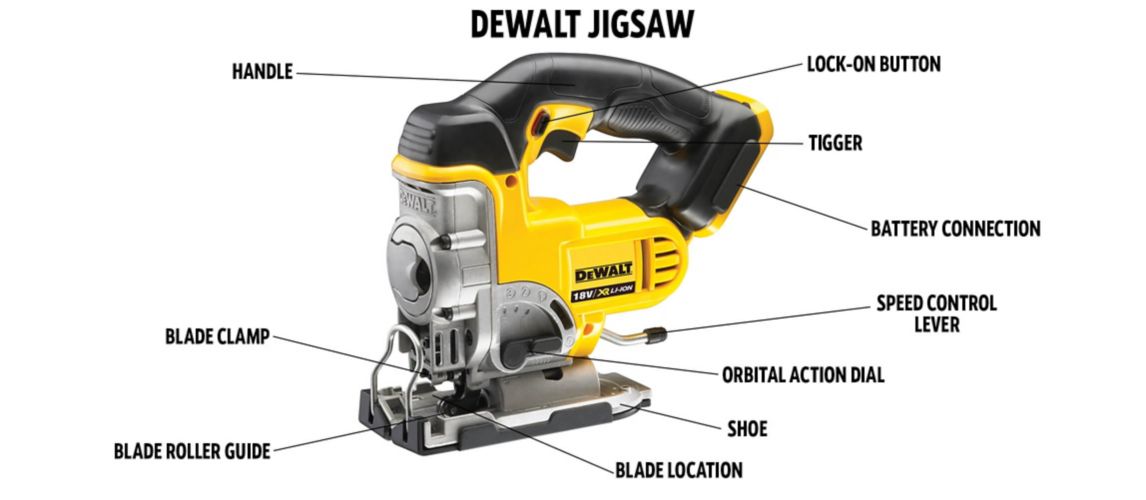
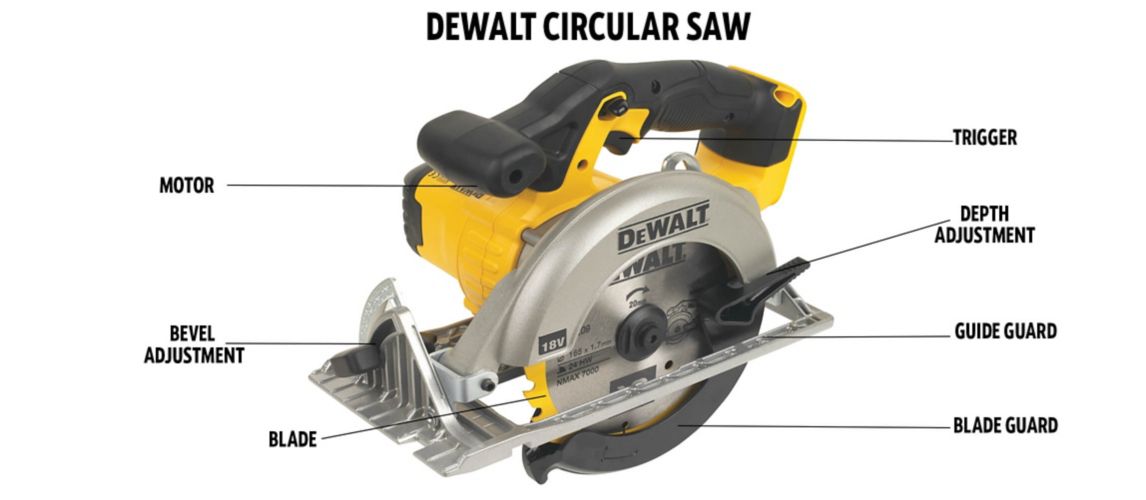
Power Ratings Explained
Power ratings on power saws are measured differently, depending on how the saw is powered.
Cordless power saws are powered by a battery, so their power is measured in volts. They can range from 10.8V to 54V. A corded saw’s power is measured in watts ranging from 80W to 2600W.
The power rating on a power saw is important because the higher the volts or wattage are, the more power the saw has. Therefore, it can tackle heavier tasks. You'll find that power saws designed for heavy-duty jobs or cutting at speed, such as cutting masonry or sheet materials, are made to be more powerful anyway. While power saws designed for light-duty or slow precision cutting have lower power ratings.
Although electric power saw power is measured in watts, they also have a voltage rating of 110V or 230V. A 230V power saw can be plugged into a standard domestic socket, so it’s suitable for use in homes, offices, etc. But a 110V power saw is designed to be plugged into an isolating transformer used on construction sites. The transformer cuts the current in half, to reduce the danger of fatal electric shocks if the cable was accidentally cut.
Battery Technology
There are three types of batteries used in cordless power saws: Nickel-Cadium (NiCad), Nickel-Metal Hydride (NiMH) and Lithium-ion (Li-ion).
NiCad batteries are the oldest technology of the three. They are known to be tough and resistant to impact and extreme temperatures, and they can have a good lifespan if they are looked after correctly. However, looking after them does take some effort. They need to be kept at 70% of their battery life or higher but should be fully discharged once a month. Their battery runs down quickly, even when they aren't in use, which means you need to charge them up every so often, even when they are being stored for prolonged periods. If the battery isn't maintained in this way, its memory is severely affected, and its lifespan diminishes.
Power saws with NiMH batteries are more expensive than those with NiCAD, but their capacity is often 2 or 3 times greater. However, they have a rapid self-discharge rate and are sensitive to extreme temperatures. They also need to be maintained in the same way NiCad batteries do. In addition, if they're left fully discharged for long periods, they deteriorate rapidly, and their lifespan is significantly shortened.
Lithium-ion batteries are the most popular batteries used in power saws because they don’t require maintenance. They can be charged at any time without affecting their memory. And they don’t self-discharge, which means they’ll always have the same charge in them as when you last used them. In addition, they charge up very quickly (typically less than an hour from empty to full) and hold more power for longer. They are also better for the environment.
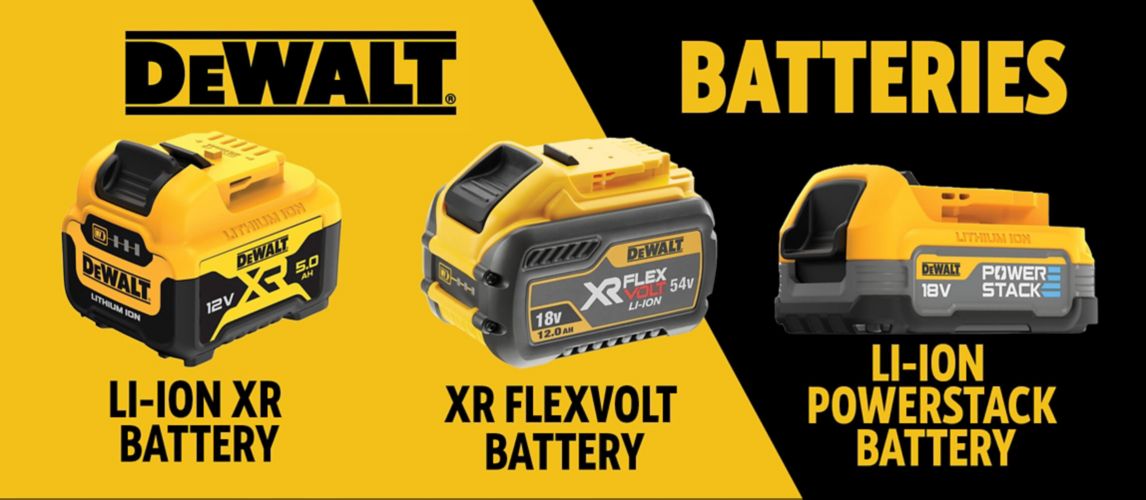
Key Considerations When Buying a Power Saw
Here are a few more things to consider before deciding which power saw type to buy:
-
How frequently and for what period of time will you use the power saw?
This is important to consider if you plan to use the power saw for long periods. If you choose a handheld power saw, select one with an ergonomic handle that's comfortable to hold. Also, if you're considering a cordless power saw, consider the battery weight, as holding a heavy battery will be tiring. -
What is the battery life?
If you've decided on a cordless power saw, check the battery capacity to determine how long it will run on a full charge. Battery capacity is measured in amp hours (Ah). The number tells you how many amps of electrical charge the battery can deliver in one hour. The higher the number, the longer you can use the saw before it runs out. -
What are the safety features?
Power saws are hazardous tools, so care should always be taken. Look out for additional safety features, such as a safety switch that ensures the tool is locked off when not in use. And a soft start switch that starts the saw moving slowly to make the first cut easier. There are also features such as safety guards and vibration protection available. With a corded power saw, you must make sure the cable is always out of the way of the cutting blade and use an RCD plug in case of accidents. -
What materials will the power saw be used on?
This is one of the most important considerations when buying a power saw. Some power saws can drill into a variety of materials, as long as you use the appropriate blade type. But for some materials, such as masonry and aluminium, there are fewer choices. The kind of material will also determine how much power you need. Generally, hard materials like concrete and metal will need more power to cut than soft materials like wood. -
What functionality will be required?
Consider which features will be beneficial for you before buying a power saw. For example, variable speed is recommended if the power saw is used with a variety of materials. Dust extraction is ideal if you regularly cut materials that create a lot of dust. And a depth adjuster will allow you to cut materials of varying thicknesses. -
What about accessories?
There’s a wide range of accessories available for power saws. Most notably, replacement blades for all saw types and materials. But there are also, for example, dust bags, clamps, mitre saw stands and rail guides for circular and plunge saws. So, check what’s available for the saw you have chosen to ensure it will meet your needs. -
What bore size or chuck type do I need?
Bore size applies to power saws that use circular blades. It’s the diameter of the hole in the blade's centre that the saw's spindle goes through. Every saw needs blades with a specific bore hole size, so always check before buying.
Chuck type applies to jigsaws and reciprocating saws. It's the part of the saw that holds the blade in place. Jigsaw chucks take blades with either a bayonet, T-shaped or U-shaped fitting, while reciprocating saw blades are universal. -
What about the number of teeth on the blades?
The number of teeth on a saw blade significantly affects the speed at which you can cut and the finish of the cut. Generally, a blade with lots of teeth will cut slower than a blade with fewer teeth. However, the more teeth there are the cleaner the cut.
